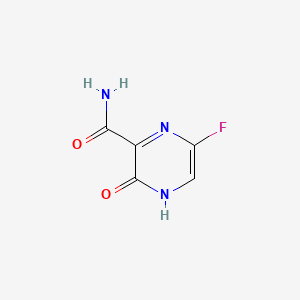



1. 6-fluoro-3-hydroxy-2-pyrazinecarboxamide
2. Avigan
3. Fabiflu
4. T-705 Cpd
1. 259793-96-9
2. 6-fluoro-3-hydroxypyrazine-2-carboxamide
3. 6-fluoro-3-oxo-3,4-dihydropyrazine-2-carboxamide
4. T-705
5. Avigan
6. 5-fluoro-2-oxo-1h-pyrazine-3-carboxamide
7. Favipiravir (t-705)
8. 6-fluoro-3-hydroxy-2-pyrazinecarboxamide
9. T 705
10. Pyrazinecarboxamide, 6-fluoro-3,4-dihydro-3-oxo-
11. 6-fluoro-3-hydroxy-pyrazine-2-carboxamide
12. Favipiravir; T-705
13. Ew5gl2x7e0
14. T705
15. Mfcd12032148
16. 2-pyrazinecarboxamide, 6-fluoro-3-hydroxy-
17. 6-fluoro-3,4-dihydro-3-oxo-2-pyrazinecarboxamide
18. Favipiravir [inn]
19. T-705 Cpd
20. Unii-ew5gl2x7e0
21. Fapilavir
22. Favilavir
23. Favipiravir [usan:inn:jan]
24. Avigan (tn)
25. Favipiravir [mi]
26. Favipiravir [jan]
27. Favipiravir [usan]
28. Favipiravir [who-dd]
29. Schembl587913
30. Favipiravir (jan/usan/inn)
31. Ampz0004
32. Chembl221722
33. Schembl15157866
34. Gtpl11139
35. Dtxsid60948878
36. Chebi:134722
37. Bcpp000056
38. Bcp02422
39. Ex-a2285
40. Bbl104098
41. S7975
42. Stl557913
43. Zinc13915654
44. Akos005166863
45. Akos015995178
46. Zinc584639712
47. Zinc584639713
48. Ccg-266269
49. Cs-0612
50. Db12466
51. Pb25591
52. Pb42412
53. Ncgc00373041-03
54. Ncgc00373041-06
55. Ac-28900
56. Da-19682
57. Hy-14768
58. Ms-20791
59. Sy110833
60. 6-fluoro-3-hydroxypyrazine-2-carbo Xamide
61. Am20080851
62. Ft-0686297
63. Ft-0701282
64. A25520
65. D09537
66. 6-fluoro-3,4-dihydro-3-oxo-pyrazinecarboxamide
67. 793p969
68. A902150
69. J-518718
70. T 705,cas;259793-96-9
71. Q16934561
| Molecular Weight | 157.10 g/mol |
|---|---|
| Molecular Formula | C5H4FN3O2 |
| XLogP3 | -0.6 |
| Hydrogen Bond Donor Count | 2 |
| Hydrogen Bond Acceptor Count | 4 |
| Rotatable Bond Count | 1 |
| Exact Mass | 157.02875454 g/mol |
| Monoisotopic Mass | 157.02875454 g/mol |
| Topological Polar Surface Area | 84.6 Ų |
| Heavy Atom Count | 11 |
| Formal Charge | 0 |
| Complexity | 282 |
| Isotope Atom Count | 0 |
| Defined Atom Stereocenter Count | 0 |
| Undefined Atom Stereocenter Count | 0 |
| Defined Bond Stereocenter Count | 0 |
| Undefined Bond Stereocenter Count | 0 |
| Covalently Bonded Unit Count | 1 |
In 2014, favipiravir was approved in Japan to treat cases of influenza that were unresponsive to conventional treatment. Given its efficacy at targetting several strains of influenza, it has been investigated in other countries to treat novel viruses including Ebola and most recently, COVID-19.
Favipiravir functions as a prodrug and undergoes ribosylation and phosphorylation intracellularly to become the active favipiravir-RTP. Favipiravir-RTP binds to and inhibits RNA dependent RNA polymerase (RdRp), which ultimately prevents viral transcription and replication.
Antiviral Agents
Agents used in the prophylaxis or therapy of VIRUS DISEASES. Some of the ways they may act include preventing viral replication by inhibiting viral DNA polymerase; binding to specific cell-surface receptors and inhibiting viral penetration or uncoating; inhibiting viral protein synthesis; or blocking late stages of virus assembly. (See all compounds classified as Antiviral Agents.)
J - Antiinfectives for systemic use
J05 - Antivirals for systemic use
J05A - Direct acting antivirals
J05AX - Other antivirals
J05AX27 - Favipiravir
Absorption
The bioavailability of favipiravir is almost complete at 97.6%. The mean Cmax for the recommended dosing schedule of favipiravir is 51.5 ug/mL. Studies comparing the pharmacokinetic effects of multiple doses of favipiravir in healthy American and Japanese subjects are below: Japanese subjects First Dose: Cmax = 36.24 ug/mL tmax = 0.5 hr AUC = 91.40 ugxhr/mL American subjects First Dose: Cmax = 22.01 ug/mL tmax = 0.5 hr AUC = 44.11 ugxhr/mL Japanese Subjects Final Dose: Cmax = 36.23 ug/mL Tmax = 0.5 hr AUC = 215.05 ugxhr/mL American Subjects Final Dose: Cmax = 23.94 ug/mL Tmax = 0.6 hr AUC = 73.27 ugxhr/mL When favipiravir was given as a single dose of 400 mg with food, the Cmax decreased. It appears that when favipiravir is given at a higher dose or in multiple doses, irreversible inhibition of aldehyde oxidase (AO) occurs and the effect of food on the Cmax is lessened.
Route of Elimination
Favipiravir's metabolites are predominantly renally cleared.
Volume of Distribution
The apparent volume of distribution of favipiravir is 15 - 20 L.
Clearance
The recommended oral dosing regimen for favipiravir is as follows: Day 1: 1600 mg twice daily; Days 2-5: 600 mg twice daily. The reported CL/F for favipiravir 1600 mg dosed once daily is 2.98 L/hr 0.30 and the CL/F values for favipiravir 600 mg dosed twice daily on days 1-2 and once daily on days 3-7 were 6.72 L/hr 1.68 on Day 1, and 2.89 L/hr 0.91 on Day 7. There is currently no reported clearance data for favipiravir 1600 mg dosed twice daily.
Favipiravir is extensively metabolized with metabolites excreted mainly in the urine. The antiviral undergoes hydroxylation primarily by aldehyde oxidase and to a lesser extent by xanthine oxidase to the inactive metabolite, T705M1.
The elimination half-life of favipiravir is estimated to range from 2 to 5.5 hours.
The mechanism of action of favipiravir is novel compared to existing influenza antivirals that primarily prevent entry and exit of the virus from cells. The active favipiravir-RTP selectively inhibits RNA polymerase and prevents replication of the viral genome. There are several hypotheses as to how favipiravir-RTP interacts with RNA dependent RNA polymerase (RdRp). Some studies have shown that when favipiravir-RTP is incorporated into a nascent RNA strand, it prevents RNA strand elongation and viral proliferation. Studies have also found that the presence of purine analogs can reduce favipiravirs antiviral activity, suggesting competition between favipiravir-RTP and purine nucleosides for RdRp binding. Although favipiravir was originally developed to treat influenza, the RdRp catalytic domain (favipiravir's primary target), is expected to be similar for other RNA viruses. This conserved RdRp catalytic domain contributes to favipiravir's broad-spectrum coverage.
